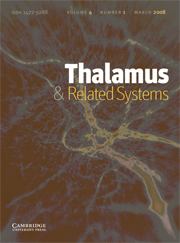Crossref Citations
This article has been cited by the following publications. This list is generated based on data provided by
Crossref.
Gallay, Marc N.
Jeanmonod, Daniel
Liu, Jian
and
Morel, Anne
2008.
Human pallidothalamic and cerebellothalamic tracts: anatomical basis for functional stereotactic neurosurgery.
Brain Structure and Function,
Vol. 212,
Issue. 6,
p.
443.
Jetzer, A.K.
Morel, A.
Magnin, M.
and
Jeanmonod, D.
2009.
Cross-modal plasticity in the human thalamus: evidence from intraoperative macrostimulations.
Neuroscience,
Vol. 164,
Issue. 4,
p.
1867.
Zurita-Cueva, Boris
Villamar, Fidel
Cornejo, Paulina
Bedoya P, Clara
Altamirano, Jorge
Navarrete Carreño, Mauricio
and
Navarrete Carreño, Osvaldo
2009.
Haz prerrúbrico de Papez y zona incierta caudal en la enfermedad de Parkinson.
NeuroTarget,
Vol. 4,
Issue. 3,
p.
41.
Zurita-Cueva, Boris
Zambrano Villamar, Fidel
and
Tapia Velásquez, Jaime
2011.
Ventajas de Combinar la Subtalamotomía Dorsolateral y la Tractotomía Pálido-Talámica en la Enfermedad de Parkinson Avanzada: Nota Técnica.
NeuroTarget,
Vol. 6,
Issue. 2,
p.
90.
Moser, David
Zadicario, Eyal
Schiff, Gilat
and
Jeanmonod, Daniel
2013.
MR-guided focused ultrasound technique in functional neurosurgery: targeting accuracy.
Journal of Therapeutic Ultrasound,
Vol. 1,
Issue. 1,
p.
3.
Magara, Anouk
Bühler, Robert
Moser, David
Kowalski, Milek
Pourtehrani, Payam
and
Jeanmonod, Daniel
2014.
First experience with MR-guided focused ultrasound in the treatment of Parkinson's disease.
Journal of Therapeutic Ultrasound,
Vol. 2,
Issue. 1,
Werner, B.
and
Martin, E.
2015.
Transkranieller fokussierter Ultraschall.
Der Radiologe,
Vol. 55,
Issue. 11,
p.
976.
Galkin, M. V.
2016.
The use of transcranial focused ultrasound in CNS diseases.
Voprosy neirokhirurgii imeni N.N. Burdenko,
Vol. 80,
Issue. 2,
p.
108.
Horisawa, Shiro
Nanke, Magi
Kawamata, Takakazu
and
Taira, Takaomi
2019.
Pallidothalamic Tractotomy for Parkinson Disease with 1-Year Follow-Up: A Case Report.
World Neurosurgery,
Vol. 121,
Issue. ,
p.
193.
Gallay, Marc N.
Moser, David
Federau, Christian
and
Jeanmonod, Daniel
2019.
Anatomical and Technical Reappraisal of the Pallidothalamic Tractotomy With the Incisionless Transcranial MR-Guided Focused Ultrasound. A Technical Note.
Frontiers in Surgery,
Vol. 6,
Issue. ,
Horisawa, Shiro
and
Taira, Takaomi
2019.
Surgical Treatment for Parkinson's Disease.
The Japanese Journal of Rehabilitation Medicine,
Vol. 56,
Issue. 3,
p.
185.
Gallay, Marc N.
Moser, David
and
Jeanmonod, Daniel
2019.
Safety and accuracy of incisionless transcranial MR-guided focused ultrasound functional neurosurgery: single-center experience with 253 targets in 180 treatments.
Journal of Neurosurgery,
Vol. 130,
Issue. 4,
p.
1234.
Horisawa, Shiro
Fukui, Atsushi
Tanaka, Yukiko
Wendong, Lew
Yamahata, Hayato
Kawamata, Takakazu
and
Taira, Takaomi
2019.
Pallidothalamic Tractotomy (Forel's Field H1-tomy) for Dystonia: Preliminary Results.
World Neurosurgery,
Vol. 129,
Issue. ,
p.
e851.
Godinho, Fabio
Magnin, Michel
Filho, Paulo Terzian
Reis, Paul
Moraes, Osmar
Nascimento, Marivaldo
Costa, Carlos
de Oliveira, Maira Okada
and
Rocha, Maria Sheila
2019.
Stereotactic Lesion in the Forel's Field H: A 2-Years Prospective Open-Label Study on Motor and Nonmotor Symptoms, Neuropsychological Functions, and Quality of Life in Parkinson Disease.
Neurosurgery,
Vol. 85,
Issue. 4,
p.
E650.
Chung, Beom Sun
and
Park, Jin Seo
2020.
Whole course of pallidothalamic tracts identified on the sectioned images and surface models.
Clinical Anatomy,
Vol. 33,
Issue. 1,
p.
66.
Gallay, Marc N.
Moser, David
Rossi, Franziska
Magara, Anouk E.
Strasser, Maja
Bühler, Robert
Kowalski, Milek
Pourtehrani, Payam
Dragalina, Christian
Federau, Christian
and
Jeanmonod, Daniel
2020.
MRgFUS Pallidothalamic Tractotomy for Chronic Therapy-Resistant Parkinson's Disease in 51 Consecutive Patients: Single Center Experience.
Frontiers in Surgery,
Vol. 6,
Issue. ,
Rocha, Maria Sheila Guimarães
de Freitas, Julian Leticia
Costa, Carlos Daniel Miranda
de Oliveira, Maira Okada
Terzian, Paulo Roberto
Queiroz, João Welberthon Matos
Ferraz, Jamana Barbosa
Tatsch, João Fellipe Santos
Soriano, Diogo Coutinho
Hamani, Clement
and
Godinho, Fabio
2021.
Fields of Forel Brain Stimulation Improves Levodopa-Unresponsive Gait and Balance Disorders in Parkinson's Disease.
Neurosurgery,
Vol. 89,
Issue. 3,
p.
450.
Guridi, Jorge
and
Gonzalez-Quarante, Lain Hermes
2021.
Revisiting Forel Field Surgery.
World Neurosurgery,
Vol. 147,
Issue. ,
p.
11.
Horisawa, Shiro
Miyao, Satoru
Hori, Tomokatsu
Kohara, Kotaro
Kawamata, Takakazu
and
Taira, Takaomi
2021.
Comorbid seizure reduction after pallidothalamic tractotomy for movement disorders: Revival of Jinnai’s Forel‐H‐tomy.
Epilepsia Open,
Vol. 6,
Issue. 1,
p.
225.
Gallay, Marc N.
Moser, David
Magara, Anouk E.
Haufler, Fabio
and
Jeanmonod, Daniel
2021.
Bilateral MR-Guided Focused Ultrasound Pallidothalamic Tractotomy for Parkinson's Disease With 1-Year Follow-Up.
Frontiers in Neurology,
Vol. 12,
Issue. ,


